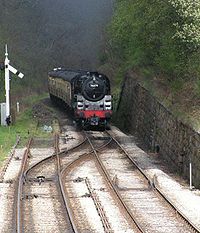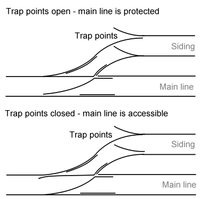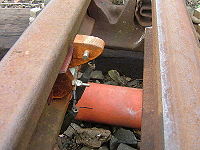
Catch point
Encyclopedia

Catch points and trap points are types of turnout
Railroad switch
A railroad switch, turnout or [set of] points is a mechanical installation enabling railway trains to be guided from one track to another at a railway junction....
which act as railway safety
Safety
Safety is the state of being "safe" , the condition of being protected against physical, social, spiritual, financial, political, emotional, occupational, psychological, educational or other types or consequences of failure, damage, error, accidents, harm or any other event which could be...
devices. Both work by guiding railway carriages and trucks
Railroad car
A railroad car or railway vehicle , also known as a bogie in Indian English, is a vehicle on a rail transport system that is used for the carrying of cargo or passengers. Cars can be coupled together into a train and hauled by one or more locomotives...
from a dangerous route onto a separate, safer track. Catch points are used to derail vehicles which are out of control on steep slopes (known as runaways). Trap points are used to protect main railway lines from unauthorised vehicles moving onto them from sidings
Rail siding
A siding, in rail terminology, is a low-speed track section distinct from a running line or through route such as a main line or branch line or spur. It may connect to through track or to other sidings at either end...
or branch line
Branch line
A branch line is a secondary railway line which branches off a more important through route, usually a main line. A very short branch line may be called a spur line...
s. Either of these track arrangements may lead the vehicles into a sand drag or safety siding, track arrangements which are used to safely stop them after they have left the main tracks.
A derail is another device used for the same purposes as catch and trap points.
Trap points


Rail siding
A siding, in rail terminology, is a low-speed track section distinct from a running line or through route such as a main line or branch line or spur. It may connect to through track or to other sidings at either end...
or where a secondary track joins a main line. A facing
Facing and trailing
Facing and trailing are terms used to describe railway turnouts in respect to whether they are divergent or convergent. When a train traverses a turnout in a facing direction, it may diverge onto either of the two routes...
turnout is used to prevent any unauthorised movement that may otherwise obstruct the main line. The trap points also prevent any damage that may be done by a vehicle passing over points not set for traffic joining the main line. In the United Kingdom
United Kingdom
The United Kingdom of Great Britain and Northern IrelandIn the United Kingdom and Dependencies, other languages have been officially recognised as legitimate autochthonous languages under the European Charter for Regional or Minority Languages...
, the use of trap points at siding exits is required by government legislation.
An unauthorised movement may be due to a runaway wagon
Railroad car
A railroad car or railway vehicle , also known as a bogie in Indian English, is a vehicle on a rail transport system that is used for the carrying of cargo or passengers. Cars can be coupled together into a train and hauled by one or more locomotives...
, or may be a train passing a signal at danger
Signal passed at danger
A Signal passed at danger , in British railway terminology, occurs when a train passes a stop signal without authority to do so. It is a term primarily used within the British Railway Industry, although it can be applied worldwide.-Categories of SPAD:...
. When a signal
Railway signal
A signal is a mechanical or electrical device erected beside a railway line to pass information relating to the state of the line ahead to train/engine drivers. The driver interprets the signal's indication and acts accordingly...
controlling passage onto a main line is set to "danger", the trap points are set to derail any vehicle passing that signal. Interlocking
Interlocking
In railway signalling, an interlocking is an arrangement of signal apparatus that prevents conflicting movements through an arrangement of tracks such as junctions or crossings. The signalling appliances and tracks are sometimes collectively referred to as an interlocking plant...
is used to make sure that the signal cannot be set to allow passage onto the main line until the trap points have been aligned to ensure this movement can take place.
Trap points should preferably be positioned to ensure that any unauthorised vehicle is stopped a safe distance from the main line. However, due to space limitations, it is not always possible to guarantee this.
If the lines are track circuit
Track circuit
A track circuit is a simple electrical device used to detect the absence of a train on rail tracks, used to inform signallers and control relevant signals.- Principles and operation :...
ed, then a track circuit interrupter
Track circuit interrupter
A track circuit interrupter may be fitted at catch points, trap points or buffer stops to maintain a track circuit in the 'occupied' state in the event of a derailment. The track circuit remains de-energised until the interrupter is replaced....
will be fitted to one of the run-off rails. When a train runs off it will break the track circuit and set main line signals to 'danger'.
Types of trap points
There are several different ways of constructing trap points:- A single tongue trap consists of only one switch rail, leading away from the main line to a short tongue of rail. This is usually placed in the rail furthest from the main line.
- Double trap points are a full turnout, leading to two tongues. Usually the tongue nearer the main line is longer than the other.
- Trap points with a crossing are double trap points where the tongues of rail are longer, so that the trap point rail nearest the main line continues over the siding rail with a common crossing or frog.
- A trap road with stops is a short dead-end siding leading to some method of stopping a vehicle, such as a sand drag or buffer stopBuffer stopA buffer stop or bumper is a device to prevent railway vehicles from going past the end of a physical section of track.The design of the buffer stop is dependent in part upon the kind of couplings that the railway uses, since the coupling gear is the first part of the vehicle that the buffer stop...
. - Wide to gauge trap points have switches that work in opposite directions and are therefore either both open or both closed. Vehicles derailed at these points will tend to continue in a forward direction rather than being thrown to one side. Wide to gauge points are typically found on sidings situated between running lines.
The type of trap points to be used depends on factors such as the gradient of the siding, and whether locomotive
Locomotive
A locomotive is a railway vehicle that provides the motive power for a train. The word originates from the Latin loco – "from a place", ablative of locus, "place" + Medieval Latin motivus, "causing motion", and is a shortened form of the term locomotive engine, first used in the early 19th...
s enter the siding.
- Independent switches are a kind of wide to gauge switch which are part of two separate crossovers. There are three positions: part of crossover A to left; wide to gauge switches; part of crossover B to right. A good place to view these independent switches are at both ends of Platforms 1 and 2 at Hornsby railway station, Sydney.
Catch points
Catch points are used where track follows a rising gradient. They are used to derailDerailment
A derailment is an accident on a railway or tramway in which a rail vehicle, or part or all of a train, leaves the tracks on which it is travelling, with consequent damage and in many cases injury and/or death....
(or "catch") any unauthorised vehicles travelling down the gradient. This may simply be a vehicle that has accidentally been allowed to run away down the slope, or could be a wagon that has decoupled from its train. In either case, the runaway vehicle could collide with a train further down the slope, causing a serious accident.
Catch points may consist of a full turnout
Turnout
Turnout may refer to:* Turnout , a rotation of the leg which comes from the hips, causing the knee and foot to turn outward, away from the center of the body* Turnout , a British film...
or a single switch blade. In some cases, on a track
Rail tracks
The track on a railway or railroad, also known as the permanent way, is the structure consisting of the rails, fasteners, sleepers and ballast , plus the underlying subgrade...
that is only traversed by uphill traffic, trailing
Facing and trailing
Facing and trailing are terms used to describe railway turnouts in respect to whether they are divergent or convergent. When a train traverses a turnout in a facing direction, it may diverge onto either of the two routes...
point blades are held in a position to derail any vehicle travelling downhill. However, any traffic travelling in the correct (uphill) direction can pass over the turnout
Turnout
Turnout may refer to:* Turnout , a rotation of the leg which comes from the hips, causing the knee and foot to turn outward, away from the center of the body* Turnout , a British film...
safely, pushing the switch blades into the appropriate position. Once the wheels have passed, the catch points are forced back into the derailing position by spring
Spring (device)
A spring is an elastic object used to store mechanical energy. Springs are usually made out of spring steel. Small springs can be wound from pre-hardened stock, while larger ones are made from annealed steel and hardened after fabrication...
s. In these cases, a lever may be provided to temporarily override the catch points and allow safe passage down the gradient in certain controlled circumstances.
The use of catch points became widespread in the United Kingdom
United Kingdom
The United Kingdom of Great Britain and Northern IrelandIn the United Kingdom and Dependencies, other languages have been officially recognised as legitimate autochthonous languages under the European Charter for Regional or Minority Languages...
after the Abergele train disaster
Abergele train disaster
The Abergele rail disaster, which took place near the town of Abergele, on the north coast of Wales in 1868, was, at the time, the worst railway disaster yet in Britain, and also the most alarming. The Railway News said of it...
, where runaway wagons containing paraffin oil (kerosene) collided with an express train
Express train
Express trains are a form of rail service. Express trains make only a small number of stops, instead of stopping at every single station...
. Catch points continued to be used in the UK until the mid-20th Century. At this time, continuous automatic brakes
Brake (railway)
Brakes are used on the cars of railway trains to enable deceleration, control acceleration or to keep them standing when parked. While the basic principle is familiar from road vehicle usage, operational features are more complex because of the need to control multiple linked carriages and to be...
, which automatically stop any vehicles separated from their train, were widely adopted, making catch points largely obsolete.
Sand drag
In some cases, catch points and trap points direct vehicles into a sand drag or safety siding, also sometimes called an arrestor bed. This may be a sidingRail siding
A siding, in rail terminology, is a low-speed track section distinct from a running line or through route such as a main line or branch line or spur. It may connect to through track or to other sidings at either end...
simply leading to a mound of sand
Sand
Sand is a naturally occurring granular material composed of finely divided rock and mineral particles.The composition of sand is highly variable, depending on the local rock sources and conditions, but the most common constituent of sand in inland continental settings and non-tropical coastal...
, gravel
Gravel
Gravel is composed of unconsolidated rock fragments that have a general particle size range and include size classes from granule- to boulder-sized fragments. Gravel can be sub-categorized into granule and cobble...
or other granular material, or a siding where the rails are within sand-filled troughs. This method of stopping a vehicle travelling at speed is preferred over a buffer stop
Buffer stop
A buffer stop or bumper is a device to prevent railway vehicles from going past the end of a physical section of track.The design of the buffer stop is dependent in part upon the kind of couplings that the railway uses, since the coupling gear is the first part of the vehicle that the buffer stop...
as there is less shock
Shock (mechanics)
A mechanical or physical shock is a sudden acceleration or deceleration caused, for example, by impact, drop, kick, earthquake, or explosion. Shock is a transient physical excitation....
to the vehicle involved.

